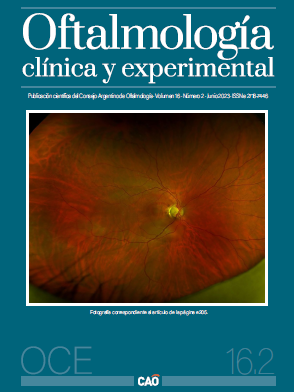Algumas notas sobre acomodação, refração e cicloplegia
a review
DOI:
https://doi.org/10.70313/2718.7446.v16.n02.223Palavras-chave:
acomodação, refração, cicloplegia, miopia, hipermetropia, presbiopiaResumo
A acomodação é uma forma de reflexo que, sendo mediada por muitas células, é denominada sincinese. É não intencional e produzido pelo fato de que a retina é capaz de detectar o plano da imagem sobre ela, calculando a sensibilidade ao contraste dos diferentes comprimentos de onda dos cones vermelho e azul. Como esta sincinesia involuntária está associada à tríade acomodação + convergência + miose, ela está sempre presente na refração subjetiva (ou na retinoscopia ou na autorrefratometria automática), e é importante levá-la em consideração realizando uma cicloplegia após fazer os testes subjetivos de óculos e foria, monoculares e binoculares, antes de prescrever óculos artesanais, colírios ou cirurgia, de acordo com o melhor critério médico para benefício do paciente. Neste trabalho fazemos uma revisão dos conceitos atuais sobre o tema e apontamos a importância que têm no âmbito dos cuidados médicos para a saúde visual, tanto na população escolar como em adultos, sejam eles míopes ou hipermétropes. Todos esses aspectos reforçam o conceito de que os problemas refrativos são atualmente considerados condições passíveis de tratamento médico.
Downloads
Referências
Barraquer R. Mecanismos de acomodación del ojo humano. In: Arias Puente A (ed.). Cirugía de la presbicia. Madrid: Sociedad Española de Cirugía Ocular Implanto-Refractiva (SECOIR), 2010.
Maceo BM, Manns F, Borja D et al. Contribution of the crystalline lens gradient refractive index to the accommodation amplitude in non-human primates: in vitro studies. J Vis 2011; 11: 23.
Iribarren R. Crystalline lens and refractive development. Prog Retin Eye Res 2015; 47: 86-106.
Truscott RJ. Presbyopia: emerging from a blur towards an understanding of the molecular basis for this most common eye condition. Exp Eye Res 2009; 88: 241-247.
Panorgias A, Aigbe S, Jeong E et al. Retinal responses to simulated optical blur using a novel dead leaves ERG stimulus. Invest Ophthalmol Vis Sci 2021; 62: 1.
Schaeffel F, Glasser A, Howland HC. Accommodation, refractive error and eye growth in chickens. Vision Res 1988; 28: 639-657.
Swiatczak B, Schaeffel F. Emmetropic, but not myopic human eyes distinguish positive defocus from calculated blur. Invest Ophthalmol Vis Sci 2021; 62: 14.
Schaeffel F. Functional changes in the myopic retina interfere with emmetropization. In: Ohio State University. College of Optometry. Richard and Leonora Hill Lecture Series, 2023. Available at: https://www.youtube.com/watch?v=OY5aYOzPmPc
Rozema J, Dankert S, Iribarren R. Emmetropization and non-myopic eye growth. Surv Ophthalmol 2023; in press.
Schaeffel F, Weiss S, Seidel J. How good is the match between the plane of the text and the plane of focus during reading? Ophthalmic Physiol Opt 1999; 19: 180-192.
Seidemann A, Schaeffel F. An evaluation of the lag of accommodation using photorefraction. Vision Res 2003; 43: 419-430.
Morgan IG, Iribarren R, Fotouhi A, Grzybowski A. Cycloplegic refraction is the gold standard for epidemiological studies. Acta Ophthalmol 2015; 93: 581-585.
Jacobs DS, Afshari NA, Bishop RJ et al. Refractive errors. San Francisco: American Academy of Ophthalmology, 2022. (Preferred practice pattern).
Renna A, Alió JL, Vejarano LF. Pharmacological treatments of presbyopia: a review of modern perspectives. Eye Vis (Lond) 2017; 4: 3.
Orman B, Benozzi G. Pharmacological treatments for presbyopia. Drugs Aging 2023; 40: 105-116.
Vejarano, F, Alió J, Iribarren R. Review of pharmacological treatments for presbyopia. Curr Ophthalmol Rep 2023; 11: 13-19.
Charman WN, Radhakrishnan H. Peripheral refraction and the development of refractive error: a review. Ophthalmic Physiol Opt 2010; 30: 321-238.
Holden BA, Fricke TR, Wilson DA et al. Global prevalence of myopia and high myopia and temporal trends from 2000 through 2050. Ophthalmology 2016; 123: 1036-1042.
De Tomas M, Kotlik C, Szeps A et al. Nuevos anteojos para control de la miopía. Oftalmol Clin Exp 2022; 15: e240-e243.
Beasley IG, Davies LN, Logan NS. The effect of peripheral defocus on axial growth and modulation of refractive error in hyperopes. Ophthalmic Physiol Opt 2022; 42: 534-544.
Bouman MA, Van Den Brink G. On night myopia. Ophthalmologica 1952; 123: 100-113.
Leibowitz HW, Owens DA. Night myopia and the intermediate dark focus of accommodation. J Opt Soc Am 1975; 65: 1121-1128.
Swiatczak B, Schaeffel F. Myopia: why the retina stops inhibiting eye growth. Sci Rep 2022; 12: 21704.
Downloads
Publicado
Edição
Secção
Licença
Direitos de Autor (c) 2023 Consejo Argentino de Oftalmología

Este trabalho encontra-se publicado com a Licença Internacional Creative Commons Atribuição-NãoComercial-SemDerivações 4.0.
Con esta licencia no se permite un uso comercial de la obra original, ni la generación de obras derivadas. Las licencias Creative Commons permiten a los autores compartir y liberar sus obras en forma legal y segura.







